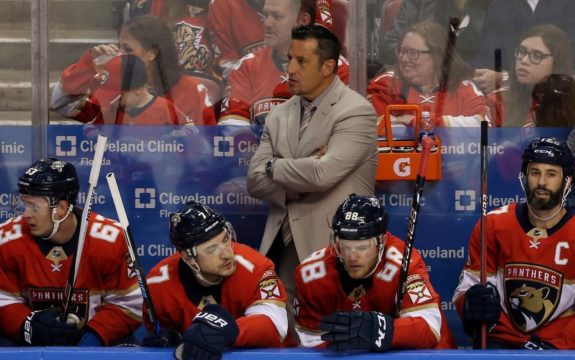Now that the regular season is over, it is time to reflect on it by looking at results and seeing how successful teams performed relative to expectations. A good way to determine this is by using the Pythagorean Expectation. The Pythagorean Expectation is a model I introduced in January that gives a team’s expected winning percentage by using goal differential.

The idea came from a similar model used in baseball using run differential. I took that basic idea and applied it to hockey using Goals For (GF) and Goals Against (GA) and then applying an exponent to it relative to the league’s scoring rates each season. The theory behind the model is that the greater a team’s goal differential (GF minus GA) the higher that team’s winning percentage should have been. That winning percentage can then be multiplied by 82 games to get an expected win total.
By knowing how many times a team was expected to win, we can see how well they performed relative to expectations. For example, if a team finished with fewer wins than expected, they underperformed relative to goal differential. This means their on-ice product was better than their record. The same works for a team with more wins than expected with a worse on-ice product than their record indicates.
In this article, I will look at the teams that outperformed expectations and whose records were better than their goal differentials.
Teams Not as Good as Their Records Indicate
There were 14 teams that outperformed their Pythagorean Expectations. Of those teams, 11 had winning records and 10 had positive goal differentials. Additionally, nine qualified for the playoffs and included all four division winners. Of the five that outperformed expectations and didn’t make the playoffs, two had winning records, the St. Louis Blues and Florida Panthers, the last two teams eliminated from playoff contention.

The Blues outplayed their expectations by the fourth-widest margin and the Panthers by the seventh widest. Both teams also won two games more than their goal differentials suggest they should have. Another team that won two additional games was the Calgary Flames, with a minus-30 goal differential and one of the most disappointing teams this season.
The Edmonton Oilers, Carolina Hurricanes, Minnesota Wild, and Winnipeg Jets all matched their win expectations. They did outperform their expected winning percentages, however. Lastly, the Toronto Maple Leafs perfectly matched their expected winning percentage and expected win totals, the only team to do so.
All of the teams listed above, with the exception of Toronto, outperformed their expectations but only by a slim margin. The teams I am interested in are the ones that widely outperformed their expectations. These were the Washington Capitals, Tampa Bay Lightning, and New Jersey Devils.
Capitals Thrived in One-Goal Games
The Capitals were the team that most outperformed their Pythagorean Expectation this season. They had an expected winning percentage of 54.5 when their actual winning percentage was 59.8, a difference of 5.3 percent. They scored 259 goals, ninth-most in the league, allowed 239, 15th fewest and their plus-20 goal differential was the 13th largest.

Although they won 49 games, they were expected to win 45, tied for the fifth-most expected wins and would have finished the season tied for the Metropolitan Division lead. They overachieved by such a large amount due to their success in one-goal games. In those games, the Capitals had a 20-6-7 record with 11 of the wins coming via overtime or shootout.
Only one of their 49 wins, an October beating of the Montreal Canadiens, was by a margin of five or more goals, tied for the fewest such wins by a playoff team this season. Their single victory by at least five goals was also fewer than the number of such wins by the Arizona Coyotes, Chicago Blackhawks, Edmonton Oilers, Montreal Canadiens, Ottawa Senators, and Vancouver Canucks. The Capitals, also, only had four wins by at least four goals.
In terms of losses, the Capitals had two losses by five or more goals, both road games — a February matchup against the Blackhawks and versus the Philadelphia Flyers in October. Furthermore, 35 of Washington’s 49 wins and 24 of their 38 regulation wins were by two or fewer goals. Similarly, 12 of their 26 regulation losses were by two or fewer goals. So the Capitals played a lot of close games this season. Of their 82 games, 54, or 65.9 percent, ended with a margin of victory or defeat of two or less goals.
Lightning Sparked by Elite Offense
The Lightning had the largest goal differential this season at plus-60, scoring 296 goals and allowing 236. They were first in the league in goals scored by a 19-goal margin and were 13th in goals allowed. That differential gave them the fourth-highest expected winning percentage at 62.4 percent but still lower than their actual 65.9 winning percentage.

Like the Capitals, the Lightning were good in one-goal games, going 23-6-6, including 11 regulation victories. Of their 54 wins, 34 were by two or fewer goals, including 22 of their 42 regulation wins. Similarly, 12 of their 23 regulation losses were by two or fewer goals.
However, at the other end, the Lightning were also great at winning by big margins as nine of their 42 regulation wins were by four or more goals. The Lightning had a lethal power play and led the league in goals due to their elite offensive talent, scoring on 23.91 percent of chances, third-best in the league.
They had five players with at least 60 points, the most of any team, and six with 20-plus goals, matched only by the Maple Leafs. For the Lightning, their six players with at least 20 goals included Vladislav Namestnikov who was dealt at the trade deadline but scored 20 before the trade.
The Lightning finished the season with the most wins and third-highest point total. However, their Pythagorean Expectation says they played like a 51-win team, tied for the second-most wins using the model. Using expectations, the Lightning would have finished one win behind the Boston Bruins in the Atlantic Division.
Devils Were a Fringe Playoff Team
The Devils were the last Eastern Conference team to clinch a playoff berth this season, finishing one point ahead of the Panthers for the last Wild Card spot. They had a 44-29-8 record with a winning percentage of 53.7 and their 44 wins were second-fewest among playoff teams. But, with just a plus-four goal differential, their expected winning percentage was 50.9, equal to 42 wins.

Their goal differential tied for 17th in the league and was the lowest of any playoff team. They also tied for 14th in GF with 248 and ranked 17th in GA with 244, the most allowed by a playoff team. With such a small goal differential, the Devils naturally were good in one-goal games and had a 25-8-9 record in them, including 11 regulation wins.
Of New Jersey’s 44 wins, 33 were in regulation and 21 of those were by two or fewer goals. By comparison, 18 of their 29 regulation losses were by two or fewer goals. They also only had three wins by at least four goals and only three losses by such a margin.
It is understandable why the Devils played so many close games and had such a small goal differential. They only had two players with 50 or more points, MVP candidate Taylor Hall and Nico Hischier — and Hall led Hischier by 41 points for the team lead. That margin was the biggest between a team’s top two scorers this season and the sixth-largest this century.
Had their record matched their on-ice product and they finished with 42 wins, they would have tied the Flyers for the fewest wins among playoff teams. They also would have tied the Flyers for the last playoff position in the Eastern Conference.
Stay tuned to learn which teams were the most underperforming of the 2017-18 season.
*All stats came from Hockey-Reference’s Play Index